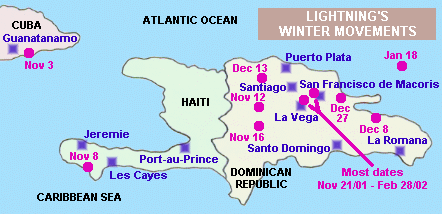

|
NOTE: This article was published in Talon Tales on March 5, 2002, immediately before Lightning achieved his fame in the Dominican Republic. For more recent news about him, visit Lightning's Project Track-'em page. |
Lightning is one of five juvenile peregrines from Richmond Hill to be monitored via satellite telemetry since 1999. Like most of his predecessors, he has made an interesting journey and has given us insights into the migratory tendencies of his species.
| Upon his arrival in Richmond Hill, Lightning was a somewhat scrawny 23-day-old chick, noticeably smaller than his brother Lionheart and step-brother Legacy, who were 26 and 32 days old at the time. Fortunately, Lightning was more than able to fend for himself. On their second day in the hack box, he proved to be the boldest of the three, rushing forward to grab the quail as soon as it was provided, and valiantly trying to drag it away from the others. Lionheart and Legacy quickly learned not to mess with "little brother". Within a few days, Lightning had become so bold that he was even stealing morsels from Lionheart’s beak if he didn’t swallow them quickly enough! |
|
The release was set for July 23, when Lightning would be 40 days old. However, he evidently didn’t feel ready to fly just yet, as on his first day of freedom he contented himself with "killing" some stones on the Town Hall roof and pounding a piece of loose string into submission. With these exercises out of the way, Lightning took flight the next day and like the other two he flew beautifully and without any problems.
Before long, it was time to select one of the Richmond Hill birds to receive a satellite transmitter. As in 1999, one bird (Legacy) was clearly the strongest of the group, and another (Lightning) was noticeably smaller than the others. Sure enough, Lightning was caught first. Had it not been for our prior experiences, this might have been a concern; however, in 1999 it was Nate who was the smallest of the birds, and he of course has thrived while wearing a transmitter ever since.
Thus it was Lightning who joined Project Track-’em on August 3. Within a couple of weeks, he was starting to make excursions east to Markham and west to Maple. However, until early September Lightning still returned regularly to the Richmond Hill Town Hall. After this he became a bit more adventurous. Following a brief swing past the Toronto Zoo, Lightning settled in North York for a few weeks, with his position confirmed not only via his transmitter, but also by office workers at Yonge and Finch who watched him on their building. This was just a temporary rest for Lightning. By early October, he made his longest trip yet, heading almost 100 km west to Guelph. On October 17, he returned to Richmond Hill for the first time in five weeks, reuniting there with Lionheart.
Until then it seemed that Lightning was reluctant to leave home, but something changed around that time. On October 21, Lightning reported to us from New Jersey, and four days later he was on the coast of Virginia. However, it was his next flight which was the most impressive. Between October 25 and October 30, he flew nearly 1800 km south to Cuba. This was bad timing though, as he arrived just in advance of Hurricane Michelle, the most severe storm to hit Cuba in half a century. Lightning was lucky to be near the country’s east end, which escaped the worst of the weather.
| Perhaps it was unrelated, but Lightning seemed to lose interest in migration after surviving the hurricane. His next flight took him just a short distance over water to Haiti, and from there he flew east into the mountainous interior of the Dominican Republic. He has remained in the country ever since, settling down eventually at San Francisco de Macoris and therefore becoming the first Project Track-’em bird to overwinter in the Caribbean. Lightning has captured the attention of local residents, and was featured on the cover of the daily newspaper Ultima Hora on March 4. |  |
As of early March, Lightning’s transmitter is still functioning, and we look forward to tracking his return journey north, expected to begin within the next few weeks.
Return to Lightning's Project Track-'em page
Lightning's Photo Gallery --- Lightning's Articles
© Canadian Peregrine Foundation